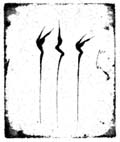5 Methodology1 How do I actually work?According to the cultural fabric of my mind, work and self respect are intertwined. This is again related to the protestant work ethic and egotism. Pride formalized is pride in under-taking Herculean tasks. I am not one to draw out ideas on paper. Rather, I model forth solutions in the materials I intend to use, in full scale samples if possible. Drawing then becomes more useful when I am familiar with the materials, methods and expression I want the work to have. Never the less, the results are always a lot different from the draw-ings. I am a slow learner, as are most people, I have discovered. With feelings of inadequacy and self doubt, it is difficult for me to trust my own judgement. Sometimes I work very slowly, thinking and muddling over things (like this paper). There are all manner of underlying hopes and fears; I want to do something wonderful like invent something as wonderful as the light bulb, but as I narrow the project down and experience the conse-quences of my decisions and actions, I am disappointed. Lucian Freud once said that a moment of complete happiness never occurs in the creation of his works of art. The promise of it is felt, but disappears towards completion of the project because he realizes that after all, it is only a picture, it will not spring to life. 2 Printmaking as a major means of artistic expressionDuring these years at school the whole breadth of print making techniques has interested me. I have tried to be highly motivated and committed to print making as a major means of artistic expression in order to be innova-tive and to produce original work. Regarding the mandate to be innovative in a master’s degree, (1.2 in Re-glement for Hovedfag: «Hovedfaget skal først og fremst søke å fornye faget»), I do not think what was in-tended was to re-invent the wheel. Technique is tightly knit to the innovation process. I believe that familiarity with processes allows one to approach pictorial, conceptual and aesthetic issues in an uninhibited manner. Yet, at times I have felt very inhibited merely because I did not have information about very basic processes or was ignorant of them. This means I have spent a lot of time trying things out. It has been difficult at times to research appropriately and effectively though, to go through all stages necessary to arrive at a valid conclusion. There are probably a lot of things I should have considered in the course of these semesters of which I am still blissfully unaware. Many times I have achieved certain results and thought I knew why such results were achieved. Maybe I even repeated those results several times. But then when unexpected results occur, I find that I did not really under-stand why I had been achieving the results in the first place. Then the process begins to understand what went wrong and to do enough experiments in order to find out what really happened in order to repeat the wished for result. Along the way, other interesting things happen but there is hardly time to pursue them. These surprises occur all the time and are the basis for further projects. 3 Artist/scientist, artisan, or hack?I have practiced the «slump» method a lot. If I can achieve wished for results with just an eye measure, or by just listening to the squelching sound of paper pulp plus sizing, or even by smelling the paper, then it must mean that I know much more than the theory of what I’m doing. While I do the physical labor, I think about what things mean to me. I interpret the pictures to myself. I hope a lot, and am quite irritated and frustrated at times. Titian is recorded to have said that if a person does not know how to solve a problem, he should turn the picture against the wall for a few months, and if when he looks at it again he still doesn’t know what to do with it, he should find another occupation. If I took Titian’s advice, I would not be doing this. When success eludes me, I keep at it. Usually I do projects three times and each time «turn it to the wall». By the third time I am usually satisfied enough to go on to another project. I like to have lots of projects going at the same time. Thomas Edison was said to have about forty going si-multaneously so why can’t I? Not everything needs to result in something finished. On the other hand, Michelangelo gave a critique of late 15th century Dutch painting which I also identify with: «This art aims at achieving several things at the same time, of which a single one would be important enough to demand the devotion of all the artists’ powers.» |
